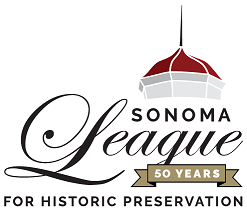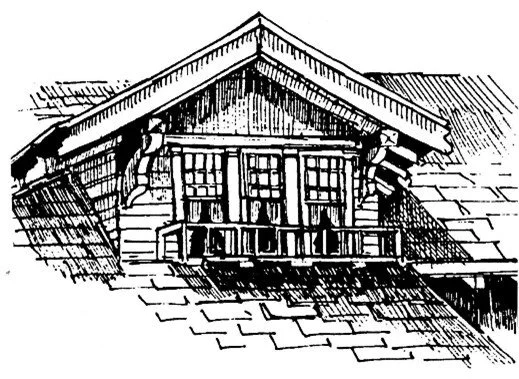-
![]()
East Spain Street
Spain Street was originally “Calle Vallejo,” because Vallejo’s home, Casa Grande, was on it.
-
![]()
Mission San Francisco Solano
114 East Spain Street
1841
The northernmost and the last of 21 California missions, the site was selected by Fr. Jose Altimira in 1823. The mission was named for a Peruvian saint. The building you see before you is not the original mission, which was a wooden structure dating back to 1824. A large adobe church structure was begun in 1827 by Fr. Buenaventura Fortuny. Around 1830, nearly 1,000 Indians were in residence. The present chapel was built as a parish church by Gen. Vallejo in 1841. All that survives from the Mission days is a portion of the Padres’ House.In 1881, in a ruined condition, the building was sold to Solomon Schocken who used it variously as a hay barn, winery and blacksmith shop. The building was substantially weakened by the 1906 earthquake.
The restored adobe has been stuccoed and features wood lintels, hand-hewn timbers tied together with rawhide straps and a tile roof supported on boughs. The earthen floor is bricked and tiled. The original Mission bell hangs under a heavy beam. A large clump of ancient cactus fills most of the north side. The belfry was added to the peak of the front gable roof about 1850 and later removed. Although extensively altered through restoration, the Mission represents the establishment of contemporary history in Sonoma (CHL No. 3). -
![]()
The Blue Wing Inn
125-139 East Spain Street
c. 1830
The earliest portion of this structure housed Sonoma’s first non-Native American family, that of Juan Miranda, the mayordomo of the Mission.
In 1849, James Cooper and Thomas Spriggs, former British seamen, purchased the property and added the present first and second floors to create a combined hotel and saloon known as the Sonoma House, later the Blue Wing Inn.Used as a grocery store and later as a wine cellar, it provided the wine used to put out the fire that destroyed all of First Street East in 1911. Restored in 1947; building acquired by the California Department of Parks in 1968. (CHL No. 17).
-
![]()
Pinni House
147 East Spain Street
c. 1906
A stoneworker named Pinni built this small, single-story, square, hip roof house. At the time Pinni bought it, the property was owned by Augostino Pinelli. Pinni used rubble from Schocken Quarry (No. 10) where he worked. The plaster, which originally covered the stone, has been removed. Note the segmental arched windows and frames with thick plaster casings, the wooden front door and wrought iron work. -
![]()
Solomon Schocken Houses
130, 138 and 146 East Spain Street
c. 1886 and 1890s
These three small, square, single-story, hipped-roof cottages were built by Solomon Schocken on land that was originally the site of the Mission church and part of the campo santo, or cemetery.From here can be seen Schocken Hill, site of one of the many quarries in Sonoma area which had vast deposits of basalt left by prehistoric volcanic activity. One of the biggest quarry owner-operators was Solomon Schocken, a merchant with store and residence in the Barracks (No. 13), who purchased this 62acres of land in 1880. In the 1880s and 1890s, quarries were Sonoma’s third largest industry, after wineries and dairies, and employed several hundred men. They furnished paving blocks for San Francisco, Petaluma and San Jose until the use of asphalt destroyed the basalt industry.
-
![]()
Castagnasso Farm
196 East Spain Street
c. 1890
This unaltered property with rural environment in the midst of a residential neighborhood includes a two-story farmhouse, two picturesque barns, sheds, pastureland, and remains of old vineyard. The house features a variety of roof lines, including large, broad gambrel roof.The lot was once owned by C. Leiding, but the original owner of the improved property is thought to have been ‘Wild Bill’ Russell. Harry Castagnasso purchased it in 1919. He had Clydesdale horses and wagons which he used to parade around the countryside to advertise beer. It is now owned by his son.
-
![]()
Ray/Adler Adobe
205 East Spain Street
c. 1846-1851
The Monterey style adobe and wooden structure is basically unmodified. It features a two-story broad veranda on the north erected by John Ray, a Virginian, in 1846. Prospering in gold rush, he finished the adobe section in 1851 and later sold it to Lewis Adler, a local pioneer merchant. The hip roof with wood shingles is typical of the style, as are the 22-inch-thick walls of adobe in the front section. A redwood structure with unusual window detail was added later at the back.During occupation of California by U.S. troops, the house served as Officers’ Mess for the detachment of General Persifor Smith; upstairs was used as Masonic meeting hall, the first Lodge in Sonoma.
-
![]()
Winkle House
206 East Spain Street
c. 1902
This hip-roof, square, two-story residence was built by Adam Adler for his aunt, Alicia Winkle, and features a porch across the. front. The second floor has gabled-roof dormers on the south and west sides. -
![]()
Adam Adler House
220 East Spain Street
c. 1910
Adam Adler, son of Lewis Adler, built this large two-story wood bungalow incorporating an existing adobe which is now part of the dining room wing at the back of the house. It features a steep gabled overhanging roof with exposed rafters. The porch, enclosed later, has Tudor type arches. Adam Adler had a mill and lumber yard on the property. -
![]()
Hope House
245 East Spain Street
c mid-1850s
This house is believed to be one of earliest wood frame houses built in Sonoma. When first built, sometime between 1852 and 1857, it was about 18 by 36 feet; it was added to in the 1940s. The original structure contains wide horizontal redwood board siding with butt joints, small casement windows in pairs and two wood paneled doors.
The house was sold in 1861 to a blacksmith and wagon-maker named Hope. -
![]()
Lewis Adler’s First Store
256 East Spain Street
c. 1848
This two-story, gabled-roof residence, featuring a shed-roof-covered front porch, has had a colorful history. It was originally a one-story with lean-to and the early store of Lewis Adler and Charles Meyer. They moved their commercial building farther west on Spain Street, opposite the Blue Wing. In 1856, the building was relocated at today’s First Street East and Napa Street as Adler’s “Pioneer Saloon.” The second story was added in 1878. It was sold to Henry Castagnasso in 1902 and moved to its present location. Despite alterations, the old building is still in character with its original design.
Item 1 of 11






